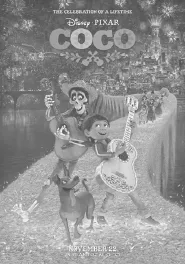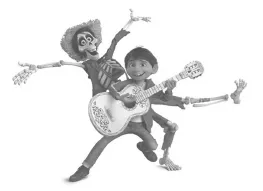“Coco” Brings the Pixar Touch to Death
2018-03-30ByScott
By A.O. Scott
One of the pleasures of a new Pixar feature is the chance to be amazed by what animation can do. Sometimes you witness a big, bold breakthrough,like the computer-assisted rendering of fur in “Monsters, Inc.”, of water in “Finding Nemo”, or of metal in “Cars”. The innovations in “Coco” are no less satisfying for being of a more subtle kind. The grain of leather and the rusted folds of corrugated metal have a rough, almost tactile quality. Human bones, hairless dogs and orange flower petals look uncannily (but not too uncannily) real. There are moments of cinematic rigor—when the animators mimic the movements and focal effects of an old-fashioned camera in actual physical space—that will warm any film-geek’s heart. Not to mention the Frida Kahlo-inspired musical number with dancing papaya seeds1影片以弗里达·卡罗为原型创造了一个人物,存在于亡灵世界,在那里担任舞台设计,其设计的一台剧目中,有亡灵从木瓜中爬出伴随音乐起舞。.
观看皮克斯新片的乐趣之一,就是能再度惊叹动画的呈现能力。有时你会见正重大的突破,比如电脑辅助设计形成的大胆创新——不管是《怪兽电力公司》中的怪物皮毛、《海底总动员》中的水流,还是《汽车总动员》中的金属,都是如此。与这三部动画相比,《寻梦环游记》毫不逊色,它的细节处理更为细致。皮革的纹理和波纹金属锈迹斑斑的褶皱都略带粗糙感,几乎可以透过屏幕触摸到。人形骷髅、无毛狗和橙色花瓣看起来真实且神秘(但并不诡异)。电影有些画面制作很严密——制作者们模仿真实物理空间中老式相机的移动和聚焦效果——对任何一个电影迷来说,这无疑都是倍感暖心的时刻。更不用说电影中以弗里达·卡罗为灵感而创作的乐曲以及随之翩翩起舞的木瓜种子。

[2] “Coco” is also one of those Pixar movies that attempt a conceptual breakthrough, an application of the bright colors and open emotionalism of modern, mainstream animation to an unlikely zone of experience. From the very start, the studio has explored the inner lives of inanimate objects like lamps and toys with a tenderness we now take for granted. It has also summoned the post-human future (“Wall-E”) and the human unconscious (“Inside/Out”) with breathtaking ingenuity. And now it has set out to make a family-friendly cartoon about death.
[3] Don’t let that scare you or your children away. There is a murder and a fatal church-bell-related accident, but the afterlife in “Coco” is a warm and hectic place, more comical than creepy.The story takes place during the Day of the Dead, when according to Mexi-can tradition (at least as interpreted by Lee Unkrich and Adrian Molina,who directed the screenplay written by Mr. Molina and Matthew Aldrich), the border controls between life and death relax and the departed are allowed temporary passage to the land of the living.A young boy named Miguel (voiced by Anthony Gonzalez) makes the trip in reverse, which is not to say that he dies,but rather that his living self, through one of several metaphysical loopholes that the movie explains as it goes along,is transported into a fantastical world of specters and skeletons, who hold fabulous parties and raucous outdoor concerts.
[2]皮克斯的很多影片是在尝试概念的突破(绚丽色彩的运用),并将现代主流动画的情感引入之前不太可能触及的体验领域,《寻梦环游记》就是这样一部力作。皮克斯工作室从制作第一部电影开始,就一直在探索像照明灯、玩具这些无生命之物的内心世界,探索之细腻,我们如今已习以为常。除此之外,皮克斯还运用其惊人的创造力探索了未来后人类世界(《机器人总动员》)和脑内情绪的缤纷世界(《头脑特工队》)。2017年,皮克斯工作室尝试制作了这部以死亡为主题,适合全家观看的动画片。
[3]千万别让这个主题吓跑了你或孩子们。确实,影片中出现了谋杀,还有教堂大钟造成的事故,但是,《寻梦环游记》呈现的死后世界是一个温暖而热闹的地方,并不让人毛骨悚然,而是满满趣味。故事发生在墨西哥亡灵节期间。按照墨西哥传统(至少本片导演李·安克里奇和阿德里安·莫利纳是这样解释的;本片编剧除了莫利纳外,还有马修·奥尔德里奇),在亡灵节期间,生与死之间界限放松,逝者可以暂时重返生者的世界。故事中,一个名叫米格的小男孩(安东尼·冈萨雷斯配音)却偏偏来到了亡灵的世界,他并不是因去世而来到了这儿,而是某个超自然的漏洞把他,一个活人,带到了这个满是幽灵和骷髅的奇妙世界。至于这个漏洞到底是什么,在电影情节一步步展开的过程中你会找到答案。在亡灵的世界里,会举行盛大的聚会和热闹的户外音乐会。
[4] Nearly as enchanting as that magical realm is the Mexican village of Santa Cecilia, Miguel’s hometown,where he is part of a prosperous clan of shoemakers. The cultural vibe of “Coco”is inclusive rather than exoticizing,pre-empting inevitable concerns about authenticity and appropriation with the mixture of charm and sensitivity that has become something of a 21st-century Disney hallmark. Here, the importance of family—the multigenerational household that sustains and constrains the hero—is both specific and universal.It’s what explains the particular beats of Miguel’s story and what connects him to viewers regardless of background.
[5] He shows a certain kinship with other well-known recent cartoon characters. A gifted musician in a family that forbids music, he is a bit like Remy, the “Ratatouille” rat whose kin were hostile to his artistic ambition,and like Mumble, the misfit penguin in“Happy Feet.” Miguel’s genealogical quest—a search for roots, lost ancestors and information that might explain who he is—resembles Dory’s journey in “Finding Dory.” The sidekicks who accompany him, animal and (formerly)human, are drawn from a familiar well of archetypes, and the final round of lesson-learning and reconciliation hits notes we have heard many times before.
[4]跟神秘的亡灵之地具有同样魅力的是米格的家乡,一个名叫圣塞西莉亚的墨西哥小村庄。米格家族世代生活于此,靠制鞋为生,生活富裕。《寻梦环游记》呈现的是包容而非排外的文化,预先消除了人们的担忧。这个担忧针对的是独特魅力和敏感性糅合之后的真实性和适当性,而这种糅合已成为21世纪迪士尼的某种特征。影片中,家庭的重要性表现得既具体又普遍,那个多代家庭既抚育了主人公,也束缚了他。这就是米格的故事打动观众的地方,也是为什么不同文化背景的观众会跟米格产生共鸣的原因。
[6] But if “Coco” doesn’t quite reach the highest level of Pixar masterpieces,it plays a time-tested tune with captivating originality and flair, and with roving, playful pop-culture erudition.Miguel’s musical role model—and the source of the family embargo on musical expression—is a long-dead crooner and movie star named Ernesto de la Cruz (Benjamin Bratt). In life and in death, he incarnates venerable ideals of romance and wounded machismo, or at least their show-business incarnations.(His greatest hits and movie clips form part of the texture of “Coco,” the way the old “Woody’s Roundup” show did in the “Toy Story” movies.)

[5]从某种程度上来说,米格与近年来出现的其他有名的动画人物也有一定的联系。在一个禁止音乐的家庭中,他这样一个音乐天才的遭遇跟《美食总动员》中的小老鼠瑞米、《快乐的大脚》中的小企鹅曼波都有几分相似,瑞米的家人对他想要成为“厨艺大师”的梦想总是嗤之以鼻,曼波则与帝企鹅家族格格不入。米格探索家族的往事——寻根问祖,搜集信息,试图从中探求自己存在的意义——这与《海底总动员2:多莉去哪儿》中小鱼多莉的冒险之旅颇为相似。陪伴米格的伙伴,不管是动物还是亡灵,都可以找到熟悉的原型。电影最后凸显的教育意义和冲突的缓解也是我们之前在很多影片中都可以看到的。

[6]不过,即使《寻梦环游记》还算不上是皮克斯动画的巅峰之作,但其独创性和造梦天资引人瞩目,幽默不羁地传递出流行文化的方方面面,这些所打造的是经久不衰的旋律,使其经得起时间的检验。米格的音乐偶像是一位过世已久的歌手、电影明星,名叫埃内斯托·德拉科鲁兹(本杰明·布拉特配音)——也是他们家族禁止一切形式音乐的根源。德拉科鲁兹不管是在世时还是过世之后,都是值得敬慕的对象。他的身上既有理想的浪漫主义情怀,也有身为男人的无奈与不易。或者至少可以说,他代表了从事演艺事业的大多数人。(他极受欢迎的几首主打歌曲和电影片段均收录在《寻梦环游记》的原声带中,就如同《玩具总动员》系列电影原声带中收录了其主题曲《伍迪牛仔秀》。)
[7] The purer embodiment of that tradition is Héctor (Gael García Bernal), a ragged, forgotten ghost who befriends Miguel. What links Héctor with de la Cruz is a lurid story of passion, betrayal and longing. Their lives and deaths are a ballad whose meaning and melody Miguel must learn. In doing so, he will understand the thread that links him to both of them, and also the sources of the anti-musical animus that runs so strongly in his maternal line.
[7]米格的朋友埃克托(盖尔·加西亚·贝纳尔配音),一个落魄且已被世人遗忘的亡灵,更加纯粹地体现了影片所折射的传统文化观。埃克托和德拉科鲁兹之间有一个耸人听闻的,关于激情、背叛和渴望的故事。他们生前和死后的故事都如民谣般,米格都必须了解。只有这样,他才能明白自己和他们两人之间存在着怎样的关系,才能知道自己的家族,一个靠代代女性撑起的家庭,强烈反对音乐的根源。
[8]可可是米格太奶奶的名字,她才是整个故事的核心人物。太奶奶的母亲伊梅尔达(阿兰纳·乌巴奇配音)是亡灵世界中米格家族的大家长,她脾气暴躁。而太奶奶的女儿,也就是米格的奶奶(芮妮·诺埃尔·维克托配音)是一个说一不二的人,她是米格家族在人世间的家族权威。她们坚决禁止米格弹奏吉他,是因为音乐曾让她们心碎,因为吉他与男人的自私任性有联系。
[8] Coco is the name of Miguel’s great-grandmother, who turns out to be the heart of the story. Her mother,Imelda (Alanna Noël Ubach), is a furious matriarch on the other side of the grave, while Coco’s daughter, Miguel’s Abuelita (Renée Victor), is a no-nonsense flesh-and-blood autocrat. Their determination to silence Miguel’s guitar arises from heartbreak, and from the instrument’s association with the waywardness of men.
[9] “Coco” avoids the darker tones associated with this theme, in the way that old murder ballads are sometimes reconceived as children’s songs. It’s reassuring rather than haunting, which is a shrewd and successful commercial compromise,but a compromise all the same. ■
[9]《寻梦环游记》虽涉及“死亡”这一主题,但其呈现并不阴暗。一些古老的、有关“谋杀”的歌谣有时被重新演绎成儿童歌曲,《寻梦环游记》就是做了类似的演绎。影片让人倍感安心,而非让人惶恐不安——从商业的角度来说,这是一种精明而成功的妥协,但终归是一种妥协。 □

